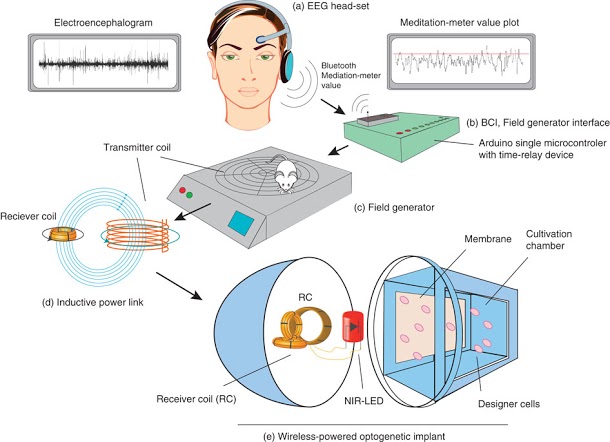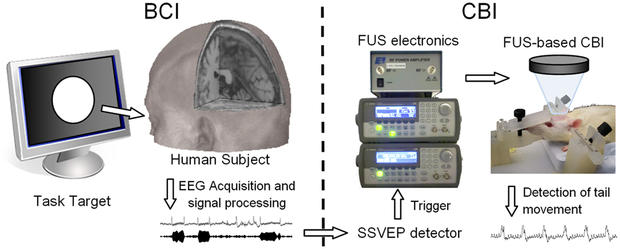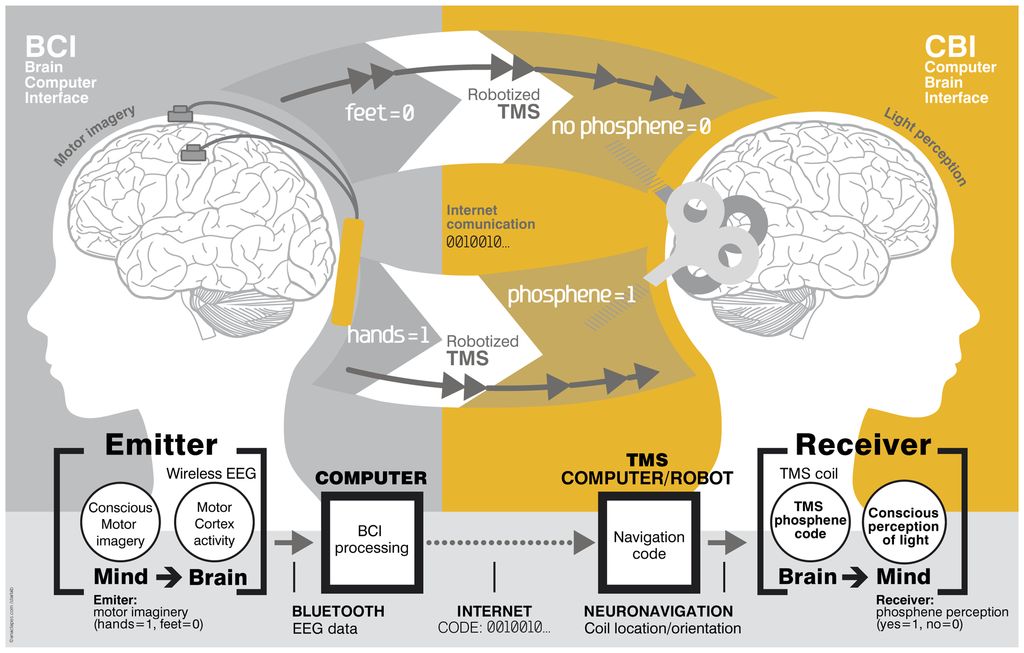
Science fiction becoming science fact
Open any book of speculative science fiction and chances are, the subject of mind control will come up. Not so much the ability to control others with one’s mind (a la telepathy or telekineses), but the ability to interface with machines, send messages, and even exercise control one’s own biological functions through sheer thought. Whether it is enabled by cybernetic implants, nanomachines, or electrodes that transmit thoughts as data, the concept of this technology-enabled kind of telepathy has been around for many decades.
Well, as the saying goes, science fiction eventually becomes science fact. And thanks to ongoing research into electroencephalography (EEG) brainwave monitors, wireless technology, brain-to-computer interfaces (BCI), brain-to-brain interfacing (BBI), mind-control is fast becoming that very thing.
And most recently, in a study that was described in Nature Communications, a group of researchers from the Department of Biosystems Science and Engineering at ETH Zurich describe how advancements made in synthetic biology, optogenetics, and brain-computer-interfaces combined to create the world's first “mind-genetic interface" (MGI). Such an interface could provide advanced treatment options for patients in the near future.
To break it down, when genes get expressed, they can be translated into proteins that serve certain cellular functions - such as releasing dopamine, seratonin, or endorphins. This sort of system could one day allow people to use their own thought processes to control the expression of genes within their own bodies and deal with anything ranging from anxiety to pain.

Using thoughts to control your biology
In their experiment, the researchers implanted a coin-sized device under the skin of mice that was made up of three components. These included a receiver-coil capable of picking up magnetic signals and converting them into an electrical current; a near infrared LED powered by that current; and a chamber for housing genetically-modified cells that respond selectively to the LED.
The mice were then placed onto a magnetic field generator that received brain activity (EEG) signals via Bluetooth from people wearing NeuroSky's MindSet EEG headsets. The people responded to biofeedback, meditated, or concentrated on a game to change the level of their brain activity, which in turn altered the magnetic field being generated and the amount of current created by the implanted device.
A set threshold of current triggered the LED to turn on and illuminate the cells in the chamber of the implanted devices, which the researchers could see lighting up through the mouse’s skin. The cells were specifically modified to express a human protein called Secreted Alkaline Phosphatase (SEAP) whenever the LED turned on that would then diffuse across a membrane and into the mouse’s bloodstream. The researchers were then able to determine that the levels of SEAP in the blood of the mice changed in accordance with changes in the mental state of the people involved.
What this boils down to is the ability to control the release of proteins in the bloodstream, proteins which have a specific biological function and can order the body to behave in ways that we want it to. Naturally, the system described by the researchers is still in its infancy and so far, they have only used human brain activity to test their implantable gene-delivery device in mice. But the process is fairly straight-forward, and human trials could be happening before long.

This is just one example of experiments involving BCI, nor is it the first time it has been accomplished between a human and a rat. For example, during the summer of 2013, researchers at Harvard Medical School created a BBI that allowed a human controller to move a portion of a rat's body.
In this case, the research team - which was led by Seung-Schik Yoo, an assistant professor of radiology - relied on focused ultrasound (FUS) rather than surgical implants or other invasive measures. FUS technology is normally used to heat and destroy diseased or damaged tissue, usually in deeper regions of the brain that cannot be reached surgically.
In this case, the FUS delivered a low-intensity blast of focused acoustic energy to stimulate brain tissue without damaging it. The human controller was hooked up to an EEG-based BCI, while the rat was hooked up to an FUS-based computer-to-brain interface (CBI). When the BCI detected brain activity in the human controller, it sent a command to the CBI, which in turn sent acoustic energy into the region of the rat's brain that controls its tail, causing it to move.
Using six different human subjects and six different rat subjects, the team achieved a success rate of 94 percent, with a time delay of 1.59 ± 1.07 seconds between user intention and the rat's response.

Similarly, in March of 2013, the first brain-to-brain interface was successfully created between two rats. The an experiment involved two research labs that were separated by thousands of kilometers, one in North Carolina and the other Brazil, to ensure that there was no chance of other information passing between them.
Using electrodes that were wired directly into a pair of rat's brains and BBIs, the researchers were able to transmit thought patterns from one rat to another through the internet. This was tested by presenting one rat (the "encoder") with instructions to push a specific lever in its cage in order to get rewarded with a food pellet.
These thoughts were then sent to the "decoder" at the other end, who responded by pushing the same correct lever in anticipation of reward. The team managed to achieve a success rate of 70%, all without the benefit of training or receiving any other visual cues about which lever to select.
However, these efforts have since been overshadowed thanks to the first BBI interfaces involving humans. The first case took place in the summer of 2013, when Rajesh Roa and Andrea Stucco - two computational neuroscience students at the University of Washington - were able to transmit thoughts between each other across campus.

From a laboratory within the university, Rao used an electroencephalography (EEG) machine to encode his thoughts while playing a video game. These thoughts were then broadcast to Stucco in another location using a Skype connection, and then translated by a transcranial magnetic stimulation (TMS). This machine was strategically placed over Stucco's left motor cortex - the part of the brain that controls movements of the hands.
Stucco then received Rao's thoughts - which involved hitting the spacebar on his computer to get his character on-screen to shoot - which she then did. Once again, the physical distance was to ensure that no change of visual cues or communication outside of the mental connection existed.
The second instance happened this past summer, and involved two neuroscience researchers who were again separated by thousands of kilometers of distance. Using the same combination of EEG and TMS technology, one researcher in India was able to transmit their thoughts to another colleague in France.
These thoughts consisted of words, which were then encoded in binary form using induced flashes of light known as "phosphenes". Not only did this experiment allow words to be conveyed across a great distance without the need for typing or vocalizing, it relied on technology that is entirely non-invasive.

Other applications of mind control technology
The applications for this sort of technology are immense. Beyond the ETH team's work in mind-genetic interaces, there is also extensive work being done with mind-controlled prosthetics and exoskeletons. At the same time, impressive applications are being created that allow people to use their thoughts to control everyday devices and high-end machinery.
Heide Pfuetzner, a paralyzed woman suffering from ALS, has been using a BCI system called IntendiX PAINTING to create works of arts since 2012. Relying on an EEG cap and two monitors, she is able to translate her thoughts into visual art using software developed by an Australian company known as g.tec.
Researchers at Berkeley also announced in the Spring of 2013 that they were using commercial EEGs to create a new form of biometric identification. In other words, they used brainwave readers to identify a user and gain access to a computer - a move which could replace passwords with passthoughts.
Researchers at the Technical Univeristy of Munich (TUM) also announced this past May that were using an EEG reader and BCI to allow a pilot to fly an airplane using only the power of their mind. This EU-funded project, known as "Brainflight", is designed to make flying accessible to more people, but will most likely have wide-ranging applications that could include greater control, improved response time, and even military applications.
Mind-controlled machinery and machine-enabled telepathy are just two amazing (and potentially frightening) possibilities that are slowly coming true, possibilities that were once confined to the realm of futurism and fiction. Who knows what other possibilities will become reality in the near future? Borganisms? Mind-machine uploading? Thought-control? Transcendence? Only time will tell...
Sources:
- boingboing.net/2014/11/13/how-to-control-mice-with-your.html
- www.nature.com/ncomms/2014/141111/ncomms6392/full/ncomms6392.html
- www.cnet.com/news/control-a-rat-with-your-brain/
- www.gizmag.com/human-brain-interface/28851/
- www.telegraph.co.uk/science/science-news/10065887/Painting-through-the-power-of-thought-enabled-by-scientists.html
- neurogadget.com/2014/08/21/first-direct-brain-brain-communication-human-minds/10520
- www.sciencedaily.com/releases/2014/05/140527101454.htm
- www.extremetech.com/computing/152827-berkeley-researchers-authenticate-your-identity-with-just-your-brainwaves-replace-passwords-with-passthoughts
- www.extremetech.com/extreme/188883-the-first-human-brain-to-brain-interface-has-been-created-in-the-future-will-we-all-be-linked-telepathically








